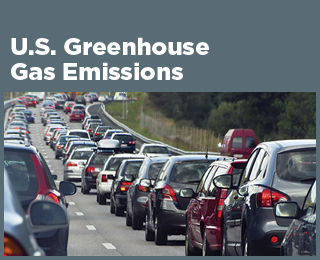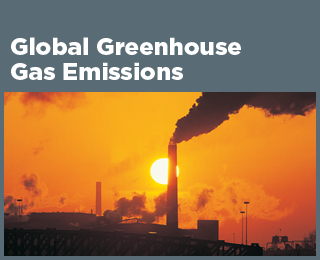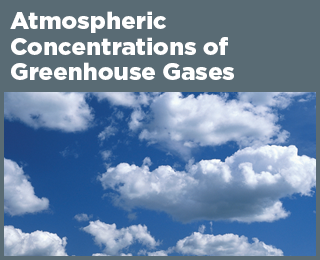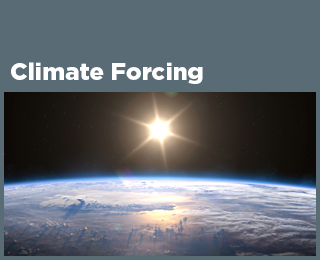Climate Change Indicators: Global Greenhouse Gas Emissions
This indicator describes emissions of greenhouse gases worldwide.
Key Points
- In 2015, estimated worldwide emissions from human activities totaled nearly 47 billion metric tons of greenhouse gases, expressed as carbon dioxide equivalents. This represents a 44 percent increase from 1990 (see Figures 1 and 2). These numbers represent net emissions, which include the effects of land use and forestry.
- Between 1990 and 2015, global emissions of all major greenhouse gases increased (see Figure 1). Net emissions of carbon dioxide increased by 50 percent, which is particularly important because carbon dioxide accounts for about three-fourths of total global emissions. Methane emissions increased the least—19 percent—while emissions of nitrous oxide increased by 26 percent. Emissions of fluorinated gases more than tripled.
- Energy production and use (including fuels used by vehicles and buildings) represent the largest source of greenhouse gas emissions worldwide (about 74 percent of the total in 2015), followed by agriculture (12 percent in 2015) (see Figure 2). While land-use change and forestry represent a net sink for emissions in the United States, absorbing carbon dioxide and offsetting emissions from other sources (see the U.S. Greenhouse Gas Emissions indicator), these activities are a net source of emissions on a global scale, largely because of deforestation.1
- Carbon dioxide emissions are increasing faster in some parts of the world (for example, East Asia and the Pacific) than in others (see Figure 3). The majority of emissions come from three regions: East Asia and Pacific, Europe and Central Asia, and the United States, which together accounted for 75 percent of total global emissions in 2021. The apparent downturn in 2020 likely reflects the worldwide reduction in travel and economic activity during the COVID-19 pandemic, as reported in the U.S. Greenhouse Gas Emissions indicator.
Background
Increasing emissions of greenhouse gases due to human activities worldwide, especially burning of fossil fuels, have led to a substantial increase in atmospheric concentrations of long-lived and other greenhouse gases (see the Atmospheric Concentrations of Greenhouse Gases indicator). Every country around the world emits greenhouse gases into the atmosphere, meaning the root cause of climate change is truly global in scope. Some countries produce far more greenhouse gases than others, and several factors—such as economic activity (including the composition and efficiency of the economy), population, income level, land use, and climatic conditions—can influence a country’s emissions levels. Tracking greenhouse gas emissions worldwide provides a global context for understanding the United States’ and other nations’ roles in climate change.
About the Indicator
Like the U.S. Greenhouse Gas Emissions indicator, this indicator focuses on emissions of gases covered under the United Nations Framework Convention on Climate Change: carbon dioxide, methane, nitrous oxide, and several fluorinated gases. These are all important greenhouse gases that are influenced by human activities, and the Convention requires participating countries to develop and periodically submit an inventory of these emissions.
Data and analysis for this indicator come from Climate Watch, which is managed by the World Resources Institute. Climate Watch compiles data from peer-reviewed and internationally recognized greenhouse gas inventories developed by EPA and other government agencies worldwide. Global estimates for carbon dioxide are published annually, but estimates for other gases, such as methane and nitrous oxide, are available only every fifth year. Climate Watch includes estimates of emissions and sinks associated with land use and forestry activities, which come from global estimates compiled by the Food and Agriculture Organization of the United Nations.
Each greenhouse gas has a different lifetime (how long it stays in the atmosphere) and a different ability to trap heat in our atmosphere. To allow different gases to be compared and added together, emissions are converted into carbon dioxide equivalents. This step uses each gas’s 100-year global warming potential, which measures how much a given amount of the gas is estimated to contribute to global warming over a period of 100 years after being emitted. Carbon dioxide is assigned a global warming potential equal to 1. This analysis uses global warming potentials from the Intergovernmental Panel on Climate Change’s (IPCC’s) Fourth Assessment Report. In that report, methane has a global warming potential of 25, which means a ton of methane emissions contributes 25 times as much warming as a ton of carbon dioxide emissions over 100 years, and that ton of methane emissions is therefore equal to 25 tons of carbon dioxide equivalents. See the table for global warming potentials from IPCC’s Sixth Assessment Report.
About the Data
Indicator Notes
Like the U.S. Greenhouse Gas Emissions indicator, this indicator does not include emissions of gases that affect climate but are not covered under the United Nations Framework Convention on Climate Change. For example, this indicator excludes ozone-depleting substances such as chlorofluorocarbons (CFCs) and hydrochlorofluorocarbons (HCFCs), which have high global warming potentials, because these gases have been or are currently being phased out under an international agreement called the Montreal Protocol. This indicator also excludes black carbon and aerosols, which most emissions inventories do not cover. There are also various emissions of greenhouse gases of natural origin, which this indicator does not cover.
Global emissions inventories for gases other than carbon dioxide are limited to five-year intervals. The United Nations Framework Convention on Climate Change database has more comprehensive data; however, these data are available mainly for a group of mostly developed countries that account for only about half of global greenhouse gas emissions. Thus, to provide a more representative measure of global greenhouse gas emissions, this indicator uses the broader Climate Watch database.
Data Sources
Data for this indicator came from the World Resources Institute’s Climate Watch database, which is accessible online at: www.climatewatchdata.org/ghg-emissions. The Climate Watch dataset consists of data that were originally collected by organizations including the International Energy Agency, the Food and Agriculture Organization of the United Nations, EPA, and the Global Carbon Project, as well as Robbie M. Andrew (CICERO Center for International Climate Research). Other global emissions estimates—such as the estimates published by the Intergovernmental Panel on Climate Change1—are based on many of the same sources.
Technical Documentation
References
1 IPCC (Intergovernmental Panel on Climate Change). (2023). Climate change 2022—Mitigation of climate change: Working Group III contribution to the Sixth Assessment Report of the Intergovernmental Panel on Climate Change (P. R. Shukla, J. Skea, R. Slade, R. Fradera, M. Pathak, A. A. Khourdajie, M. Belkacemi, R. van Diemen, A. Hasija, G. Lisboa, S. Luz, J. Malley, D. McCollum, S. Some, & P. Vyas, Eds.). Cambridge University Press. https://doi.org/10.1017/9781009157926
2 Climate Watch. (2024). Historical GHG emissions. Retrieved November 22, 2024, from www.climatewatchdata.org/ghg-emissions




